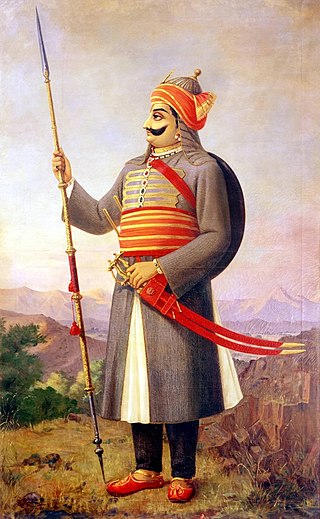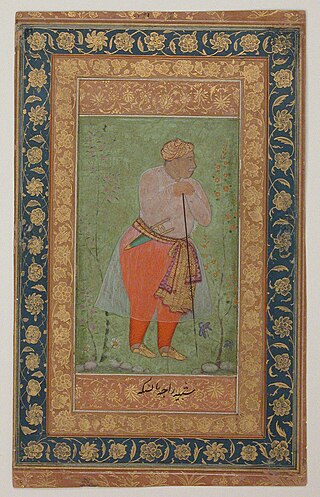Related Research Articles

Ramtanu Pandey, popularly referred to as Mian Tansen, or Sangeet Samrat, was a Hindustani classical musician. Born into a Hindu Gaur Brahmin family, he learnt and perfected his art in the northwest region of modern Madhya Pradesh. He began his career and spent most of his adult life in the court and patronage of the Hindu king of Rewa, Raja Ramchandra Singh, where Tansen's musical abilities and studies gained widespread fame. This reputation brought him to the attention of the Mughal Emperor Akbar, who sent messengers to Raja Ramchandra Singh, requesting Tansen to join the musicians at the Mughal court. Tansen did not want to go, but Raja Ramchandra Singh encouraged him to gain a wider audience and sent him along with gifts for Akbar. In 1562, at about the age of 60, the Vaishnava musician Tansen joined Akbar's court, and his performances became the subject of many court historians.

Pratap Singh I, popularly known as Maharana Pratap, was a king of Kingdom of Mewar, in north-western India in the present-day state of Rajasthan. He is notable for leading the Rajput resistance against the expansionist policy of the Mughal Emperor Akbar including the Battle of Haldighati.

Mirza RajaMan Singh I was the 24th Maharaja of Amber from 1589 to 1614. He also served as the Subahdar of Bengal for three terms from 1595 to 1606 and the Subahdar of Kabul from 1585 to 1586. He served in the Imperial Mughal Army under Emperor Akbar. Man Singh fought sixty-seven important battles in Kabul, Balkh, Bukhara, Bengal and Central and Southern India. He was well versed in the battle tactics of both the Rajputs as well as the Mughals. He is commonly considered to be one of the Navaratnas, or the nine (nava) gems (ratna) of the royal court of Akbar.

The battle of Haldighati was fought on 18 June 1576 between the Mewar forces led by Maharana Pratap, and the Mughal forces led by Man Singh I of Amber. The Mughals carried the day after inflicting significant casualties on Mewar forces, although they failed to capture Pratap, who reluctantly retreated persuaded by his fellow commanders.

Sadarang (1670–1748) was the pen name of the Hindustani musical composer and artist Naimat Khan, who was active in the eighteenth century. He and his nephew Adarang changed the Khayal style of Hindustani music into the form performed today. Naimat Khan composed Khyal for his disciples and he never performed Khyal.

Raja Bharmal, also known as Bihari Mal, and Bihar Mal, was the 22nd Kachwaha Rajput ruler of Amber, which was later known as Jaipur.

Udai Singh, often referred as the Fat was the Rathore ruler of Marwar, which was later known as Jodhpur. He was also the maternal grandfather of Shah Jahan, the fifth Mughal Emperor, and an ancestor of all subsequent emperors.
Sham Chaurasi Gharana is a vocal gharana in Hindustani classical music known for the singing of vocal duets. It is also known as the cradle of drupad. It is one of the four singing gharanas of Punjab; the other three are: Patiala, Talwandi and Kapurthala. It is most notably represented in modern times by the brothers Nazakat and Salamat Ali Khan.

Kishangarh State was a princely state of India from 1611 to 1948. It was founded by the Jodhpur prince Kishan Singh in 1609. Before Kishan Singh this area was ruled by Raja Samokhan Singh.

The siege of Chittorgarh was the military expedition of the Mughal Empire under Akbar against the Mewar kingdom that commenced in 1567 during which the Mughals successfully captured the fort of Chittorgarh after a hard-pressed siege which lasted for several months.
The Mughal–Rajput wars were a series of battles between the Rajput Confederacy and the Mughal Empire. The conflicts originated with the invasion of northwestern India by the Mughal ruler Babur, to which the head of the Rajput confederacy, Rana Sanga, offered staunch resistance.

Maharana Amar Singh I, the Maharana ruler of Mewar Kingdom, was the eldest son and successor of Maharana Pratap I.He was the 14th Rana of Mewar,ruling from January 19, 1597 till his death on January 26, 1620.

Maharana Raj Singh I, was the Maharana of Mewar Kingdom and eldest son of Maharana Jagat Singh I. He fought against Mughal Empire and annexed many Mughal territories He participated in Rajput-Mughal War (1679–1707) and defeated the Mughals.

Naubat Khan was an Indian classical music composer, musician and instrumentalist who was made a Mansabdar by Mughal Emperor Akbar. He is known today for his skills with the rudra veena or bīn, which he is shown playing in paintings by Mughal court artists. Naubat Khan was the contemporary and son in law of legendary Tansen.

Ustad Mohammad Wazir Khan(1860 – 1926) served as the head of Arbab-e-Nishat during the period of Nawab Hamid Ali Khan of Rampur. He was also an excellent playwright who established the Rampur theatre in the building of club Ghar in Rampur.
Omrao Khan beenkar was a vina wizard of the 18th century. He was a descendant of Naubat Khan.

Lal Khan was a musician in the court of the Mughal emperor Shah Jahan, who conferred the title of Gunsamundra on him on 19 November 1637.
Ameer Khan Beenkar was an illustrious veena player of the eighteenth century. He was also an outstanding dhrupad singer. He along with his uncle and father-in-law Bahadur Hussain Khan established the Rampur musical court during the period of Nawab Yusef Ali Khan and Nawab Kalbey Ali Khan. Ameer Khan went to Haj pilgrimage with Nawab Kalbey Ali Khan in the year 1872. Ameer Khan was also a capable portrait artist. His self-portrait was published in Musaddas Tahniyat-e-Jahsn-e-Benazeer written by Awadh poet and later Rampur courtier Meer Yar Ali Jaan Sahab. Musaddas is currently in Rampur Raza Library..Ameer Khan wrote Gulshan-e-Musarrat which is also preserved in Rampur Raza library.
After the mid-16th century, many Rajput rulers formed close ties with the Mughal emperors and served them in various capacities. It was because of the Rajputs that Akbar was not able to make complete Mughal Empire in India. The Rajput thakurs, who offered their daughters for marriage, formed a strong tie with the Timurid house of the Mughal Empire. The Rajput vassals had their daughters and sisters married to the Mughal emperors and their princes. For example, Akbar performed 40 marriages comprising for himself, his sons and grandsons, of which 17 were Rajput-Mughal alliances. The successors of the Mughal emperor Akbar, the mothers of his son Jahangir and grandson Shah Jahan were Rajputs. The Sisodia Rajput family of Mewar made it an honor not to enter into matrimonial relations with the Mughals, and thus stood in contrast to all other Rajput clans. After this time, the marital relations between the Rajputs and the Mughals declined somewhat. Akbar's relations with the Rajputs began when he returned in 1561 from a visit by the Chisti Sufi Shaikh of Sikri, west of Agra. Then many Rajput princesses married Mughal emperor Akbar.
References
- ↑ Agarwala, Viney K. (10 May 2010). "Traditions and trends in Indian music - Viney K. Agarwala" . Retrieved 25 June 2015.
- ↑ Barthakur, Dilip Ranjan (2003). The Music and Musical Instruments of North Eastern India - Dilip Ranjan Barthakur. ISBN 9788170998815 . Retrieved 25 June 2015.
- ↑ https://books.google.co.in/books?id=Li4uAAAAMAAJ&q=raja+samokhan+singh+akbar&dq=raja+samokhan+singh+akbar&hl=en&newbks=1&newbks_redir=0&source=gb_mobile_search&sa=X&ved=2ahUKEwjQyrrFlpKGAxXeSGwGHQIlDCY4ChDoAXoECAgQAw#raja%20samokhan%20singh%20akbar
- ↑ Sharma, Manorma (2006). Tradition of Hindustani Music - Manorma Sharma. ISBN 9788176489997 . Retrieved 25 June 2015.
- ↑ "Bhavan's Journal". 1978.
- ↑ Mukherjee, Bimal (1989). "Indian Classical Music: Changing Profiles".